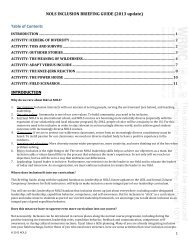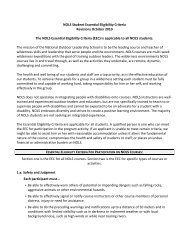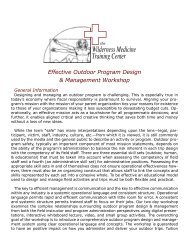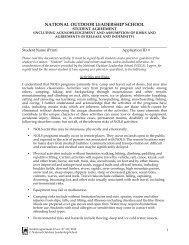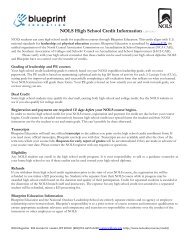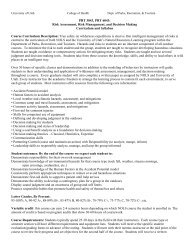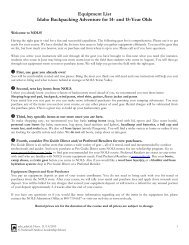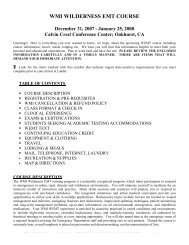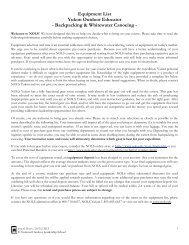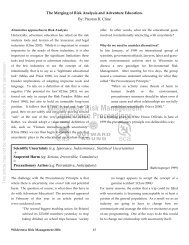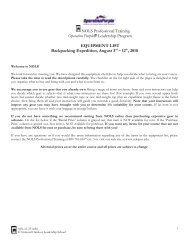introduction to the 2008 nols leadership educator notebook
introduction to the 2008 nols leadership educator notebook
introduction to the 2008 nols leadership educator notebook
Create successful ePaper yourself
Turn your PDF publications into a flip-book with our unique Google optimized e-Paper software.
some risks, succeed a bit, and maybe fail some or at least stretch abit. However, <strong>the</strong> leader can’t step back from supporting <strong>the</strong> group.NOLS students in this stage need a lot of active listening, feedback,coaching and help with <strong>to</strong>ugh spots. They don’t need you <strong>to</strong>do <strong>the</strong>ir work for <strong>the</strong>m. On a course, this is when students are leadingmost aspects of travel days.The final stage, delegating, takes place when <strong>the</strong> group membersare both ready and willing <strong>to</strong> do <strong>the</strong> task. They are ready and confident.They’ve had enough opportunity <strong>to</strong> practice and <strong>the</strong>y feelcomfortable without <strong>the</strong> leader providing direction. This is where<strong>the</strong> leader gives <strong>the</strong>m <strong>the</strong> ball and lets <strong>the</strong>m run with it. The leadermust grant group members considerable independence regardinghow <strong>the</strong>y do <strong>the</strong>ir tasks and how <strong>the</strong>y organize <strong>the</strong>mselves asa group. The leader must step back from directing and decidingthings for <strong>the</strong> group, except in very specific circumstances, so as<strong>to</strong> respect <strong>the</strong> group’s au<strong>to</strong>nomy. Still, observing and moni<strong>to</strong>ringare important <strong>leadership</strong> activities. The leader must keep a pulse onwhat’s going on.This includes NOLS’s Independent Student Group Expedition,or when students run a ration period, or any time instruc<strong>to</strong>rs are lettingstudents run <strong>the</strong> show. You are more or less an observant guest,who doesn’t step in unless parameters have been crossed (i.e. safety)or <strong>the</strong> group meets a situation <strong>the</strong>y are not yet ready <strong>to</strong> deal with.If this is what we actually do with students, should we also try <strong>to</strong>teach our students how <strong>to</strong> do this with <strong>the</strong>ir peers? Explaining <strong>the</strong><strong>the</strong>ory may be useful <strong>to</strong> <strong>the</strong>m later on, especially when <strong>the</strong>y go homeand start leading friends and family. They don’t need <strong>to</strong> verbalize <strong>the</strong>stages <strong>to</strong> <strong>the</strong>ir friends—but keeping <strong>the</strong> <strong>the</strong>ory in mind may help<strong>the</strong>m <strong>to</strong> figure out when <strong>the</strong>y should be giving more help and directionand when <strong>the</strong>y can give less.Ideas for Teaching About PowerHave your students brains<strong>to</strong>rm a list of different ways that a personhas or can get power on a NOLS course (e.g. designated leaderof <strong>the</strong> day, lots of experience, very loud voice, etc.)Ask your students <strong>to</strong> discuss how people lose power (being bossy,pretending <strong>to</strong> know things that <strong>the</strong>y don’t, etc.)Allow your students <strong>to</strong> think for <strong>the</strong>mselves and articulate how<strong>the</strong>y hope <strong>to</strong> gain and use power throughout <strong>the</strong> course.Power and LeadershipDifferent types of power work best with different styles of <strong>leadership</strong>.Here are some examples of different types of power held byleaders:Expert power: <strong>the</strong> perceived extent of relevant knowledge and skillof a personReferent (greatness) power: <strong>the</strong> extent <strong>to</strong> which o<strong>the</strong>rs want <strong>to</strong> beclose <strong>to</strong> a personAuthorized (legitimate) power: <strong>the</strong> right of a person <strong>to</strong> be influentialgiven <strong>the</strong>ir positionReward power: <strong>the</strong> extent <strong>to</strong> which a person is viewed as having <strong>the</strong>ability <strong>to</strong> give rewardsCoercive power: <strong>the</strong> extent <strong>to</strong> which a person is viewed as being able<strong>to</strong> punish o<strong>the</strong>rsInformational power: <strong>the</strong> amount of insider information a personhas about <strong>the</strong> his<strong>to</strong>ry, culture and cus<strong>to</strong>ms of a groupConnection power: <strong>the</strong> number of close relationships a person haswith o<strong>the</strong>r key members of a groupThe most influential leaders were seen as those having expert, referent,informational and connection power. The least effective powersfor influencing o<strong>the</strong>rs were found <strong>to</strong> be authorized, reward andcoercive power, although <strong>the</strong>se were not unimportant. This studyalso demonstrated that <strong>to</strong> be an influential leader over time, sharingpower and influence with <strong>the</strong> group are vital. It also says that powerstruggles can erupt when a group member has more referent andconnective power with <strong>the</strong> group than <strong>the</strong> authorized leader. I thinkwe have all seen this happen in peer <strong>leadership</strong> on courses.Teaching Leadership through Authority:Designated LeadershipThe <strong>the</strong>ory of designated <strong>leadership</strong> can be viewed as a subset ofauthorized power. Some even believe that just putting someone ina <strong>leadership</strong> role can help <strong>the</strong>m <strong>to</strong> become a good leader. Studentswho are “Leader Of <strong>the</strong> Day” are leaders by virtue of that title, <strong>the</strong>tasks that we authorize, and <strong>the</strong>ir level of accountability. NOLScourse leaders are designated leaders. The NOLS executive direc<strong>to</strong>ris a designated leader. These people have legitimate power given <strong>to</strong><strong>the</strong>m and thus also have great responsibility. See <strong>the</strong> “Leaders of TheDay” section in this book for teaching suggestions.Transformational/Visionary LeadershipTransformational leaders project a vision, motivate and inspirefollowers, engage followers in actively seeking new solutions <strong>to</strong> oldproblems and seek <strong>to</strong> raise aspiration levels among followers (Deluga,1992). Teaching notes for this <strong>to</strong>pic can be found on page 55.If a student is fortunate enough <strong>to</strong> arrive at NOLS with <strong>the</strong> characteristicsof a transformational leader, <strong>the</strong> best gift we can give heror him may be support in seeking greater self-knowledge and encouragement<strong>to</strong> use <strong>the</strong>ir skills wisely. We should also support <strong>the</strong>student in using collaborative <strong>leadership</strong> <strong>to</strong>ols so <strong>the</strong>y help createmany leaders in <strong>the</strong> group. But with beginning outdoor <strong>leadership</strong>students, visionary transformational <strong>leadership</strong> seems an impracticalgoal for <strong>the</strong> average individual. Many people do use it as a vision ina transference discussion.StewardshipOn a NOLS course, stewardship means downplaying pointsource<strong>leadership</strong>. The whole group discusses and agrees on what<strong>leadership</strong> will look like and how everyone will support <strong>leadership</strong>as a group. The student leader’s goal is <strong>to</strong> not only <strong>to</strong> get <strong>the</strong> groupfrom place <strong>to</strong> place, but <strong>to</strong> also make sure everyone has an opportunity<strong>to</strong> learn and grow.Class SuggestionsStewardship can be taught as followership or through classes onexpedition behavior.In stewardship, <strong>leadership</strong> does not emanate from a point source.Instead, it is part of everyone involved. Designing an environmentthat encourages learning and <strong>leadership</strong> in everyone is <strong>the</strong> primarytask of a steward. Personal responsibility, personal accountabilityand self-awareness are <strong>the</strong> keys<strong>to</strong>nes of this model.How does stewardship look at NOLS? The instruc<strong>to</strong>rs are akin <strong>to</strong><strong>the</strong> architects of a ship, not captains. Every student and instruc<strong>to</strong>r isresponsible for designing <strong>the</strong> course through discussion. The groupworks <strong>to</strong>ge<strong>the</strong>r <strong>to</strong> figure out how and what <strong>the</strong>y will be. A certainamount of chaos is inevitable in this model. Students and instruc<strong>to</strong>rsfeel accountable for <strong>the</strong> success or failure of any venture. The philosophyis: “People learn what <strong>the</strong>y need <strong>to</strong> learn, not what I may think<strong>the</strong>y need <strong>to</strong> learn.” (Block, 1993) Students take responsibility for<strong>the</strong>ir evaluation and growth in<strong>to</strong> <strong>the</strong>ir own hands. There is a strivingfor absolute honesty at all levels and <strong>the</strong> truth is not avoided for social<strong>2008</strong> NOLS Leadership Educa<strong>to</strong>r Notebook 13Defining Leadership




